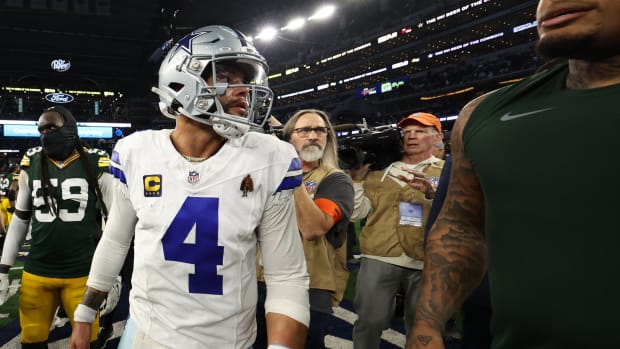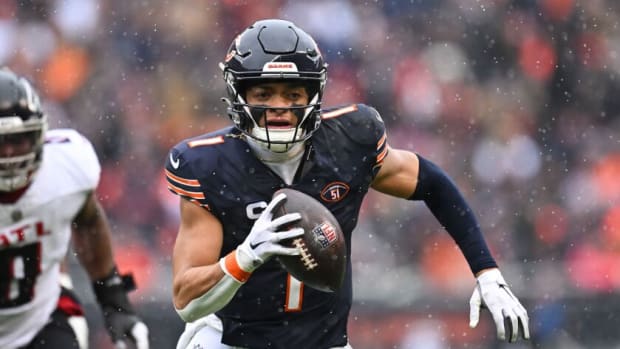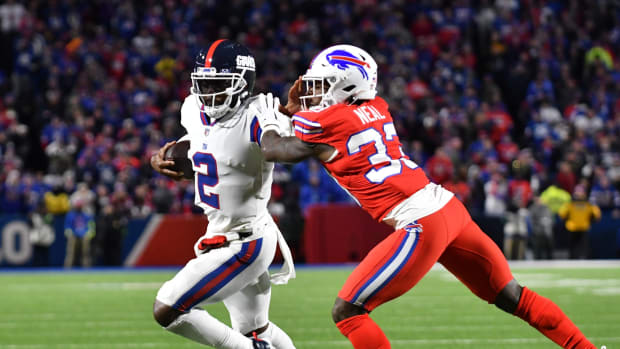Take a chance on me: Small-school players may be combine's big winners
INDIANAPOLIS — When it comes to the things that make evaluating draft prospects such a subjective process, the decision to add top-level players from less prominent programs can always get murky. Some teams will shy away from small-school talent, believing that the schematic variance and overall lack of opponent talent makes the projection from college to the NFL too difficult. That's a sensible stance on its face, until you, Mr. General Manager, are outwitted by the other GMs who understand just how to project that talent for their own systems.
The QB dance: How NFL teams develop imperfect quarterbacks
The NFL combine, where those very teams and GMs are observing whether they can make a certain guy's skill-set fit, gives the small-school players a chance to really shine. Here, those players are able to display their specific athletic talents against the best guys from the Power 5 schools. If they show off in those events, the size of their colleges matters a lot less.
This season, the most intriguing and highly rated small-school player is unquestionably North Dakota State quarterback Carson Wentz, the top player at his position to some in this draft class. Wentz looks the part at 6’5” and 237 pounds, with a plus arm and exciting athleticism. He led the Bison to FCS championships in both of his seasons as a starter, and there are times when he passes the NFL test with his poise in the pocket, ability to throw on the move, and overall accuracy. However—and this will always be the devil's advocate position with players of Wentz's status—when you're playing the Weber States and South Dakota States of the world, it's tough to estimate how your football acumen will transfer when you're facing disguised coverages from Earl Thomas and Richard Sherman, or when Von Miller is screaming off the edge, trying to put you in the hospital.
Wentz tried to allay those concerns when he spoke with the media on Thursday, and one suspects he's answered the same questions over and over from every NFL team that's shown interest.
“At North Dakota State, we were pro style, under center quite a bit. Huddle up. Over the last couple years we got really multiple with that. We ended up doing a lot of different stuff out of the gun. Still stayed true to our power football, play-action pass. But then there was more of me running the ball a little bit as well. I think that will help me tremendously going forward. I was in charge of a lot at the line of scrimmage, changing plays, run checks, all sorts of fun stuff with that. But obviously there's going to be a jump. The NFL playbook is probably twice the size of what we did, or more. I'm excited for that. I'm a student of the game. I love learning football, so I'm excited to learn that.”
Size matters? QB Brandon Allen trying to make his hands bigger
Wentz seems completely authentic in his enthusiasm, and his jump from the FCS win over Jacksonville State to the Senior Bowl indicates that he understands how to make his work register in a positive sense. Still, there's no way to know how he's going to deal with a multi-level arc in opponent strength until he's out there actually doing it.
It's one of the things that makes projecting quarterbacks of any stripe so difficult, much less quarterbacks with those untold stories. Steelers GM Kevin Colbert, who was the team's Director of Football Operations in 2004 when the team selected Miami of Ohio's Ben Roethlisberger in the first round in 2004 (and held that same position when AFC North rival Baltimore took Joe Flacco out of Delaware in the first round in 2008), echoed what many executives will tell you: If the competition level is less challenging, then absolute domination over those opponents is a must.
“You’re going to start with his physical skill-set...a player at any position at any level, if he’s playing Division III, Division II, Division I-AA, there’s a step in between each of those levels and the NFL...That doesn’t mean great players can’t come from those levels. We’ve seen a Joe Flacco playing at the University of Delaware—he’s obviously a great NFL quarterback. So, it may take them a little bit longer, but those types of players can certainly develop if they have the right skill-set.”
Jets GM Mike Maccagnan said that the bigger schools will have better and more expansive training facilities, but he's also a big believer in the idea that when those players who have been “deprived” of those advantages hit the big time, there can be great benefits.
“I tend to believe the smaller-school guys, or some late-round draft picks or even college free agents, really make great jumps as you kind of get them in,” he told me. “And sometimes the jumps they make in years 1, 2 and 3 are much more dramatic than a guy at a bigger school has reached...at that point in time.”
Nkemdiche’s peculiar presser does little to alleviate concerns
So, there's the high ceiling factor, and the allure of the unknown. For the Cardinals, who struck gold last year when they selected Northern Iowa running back David Johnson in the third round and watched him perform at an accelerated pace, it's as much about the attitudes those prospects bring to the NFL. Head coach Bruce Arians, who was undervalued as a football mind for far too long in his career, can certainly relate, and he talked specifically about the chips on those players' shoulders. Arizona's GM Steve Keim, who also bagged Delaware State defensive tackle Rodney Gunter in the fourth round of the 2015 draft, and scored big with Pittsburg State receiver John Brown in the third round of the 2014 draft, told me that he finds the underdog philosophy to be the most appealing.
“What I found with a lot of the small-school guys which has been beneficial for us, is they come in with the mindset and attitude that they are going to prove people wrong. So whether it’s Rodney Gunter, whether it’s David Johnson, they have a natural talent level, but they’ve never been given anything. When we signed [left tackle] Jared Veldheer in free agency I looked at Jared and said, here’s his skill set but he was drafted in the third round out of Hillsdale College, he’s never been given anything. He’s a guy who is going to come in here, he’s going to get this salary and he’s going to continue playing hard and not just cash the check. He’s a guy who is going to prove people wrong.”
And so it has been. Beyond Wentz, here are a few more consensus small-school stars to watch at this year's combine and beyond.
Javon Hargrave, DT, South Carolina State
Hargrave drew nascent comparisons to Ravens defensive tackle Brandon Williams among some I spoke to, and while I think that may be a bit much, the message is clear— this is a guy to watch. He first hit the national radar when he amassed six sacks against Bethune-Cookman in 2014, and expanded on that hype with a great week at the East-West game. At 6’1” and 325 pounds, the two-time MEAC Defensive Player of the Year combines brute strength with surprising agility and the ability to split gaps. Hargrave will occasionally get too high in his stance, but he's got a great lower-body burst off the snap, he's learning to use his hands to be more effective, and once in a while, he'll show the kind of speed you'd expect from a guy 50 pounds lighter.
Miles Killebrew, SS, Southern Utah
Combine or campaign? How QBs mirror presidential candidates
Opinions are divided on Killebrew, and after watching his tape, I'm a bit divided myself. at 6’2” and 219 pounds, he will at times show the kind of power and tackling ability that's reminiscent of a young Kam Chancellor to mind. Where I tend to draw the line is when I see Killebrew completely whiff on fairly easy tackles, and that's far too often for my taste. This is a player with outstanding physical stature and athleticism, but you'd like to see him rein it in. He reminds me a bit of Deone Bucannon when Bucannon was at Washington State, and you never quite knew what you were going to get from play to play. In the right NFL system, and with time and a patient coaching staff, Killebrew might be able to excel as a hybrid safety/linebacker as Bucannon has.
DeAndre Houston-Carson, DB, William & Mary
Houston-Carson has excelled as a cornerback and safety, and when you watch him play, he often exhibits the kind of range that would imply. His tackling form is solid if inconsistent, but his closing speed really stands out. Houston-Carson has an intriguing knack for crashing down from a deep safety look, tracking runners accurately, and lowering the boom. The question is whether he's got the potential to cover top NFL receivers.
Marshaun Coprich, RB, Illinois State
This two-time Missouri Valley Football Conference Offensive Player of the Year was arrested for selling marijuana to an undercover police officer in April of 2015, and reinstated to the team after a guilty plea and a two-year probation sentence. He responded to this burst of goofiness by rushing for 1,967 yards and 23 touchdowns in the 2015 season, showing the kind of toughness and short-area agility required of NFL backs. He's not a Marshawn, but Coprich reminds some of Thomas Rawls, the undrafted Seahawks rookie who excelled in Lynch's place last season. Coprich to me is more of a Justin Forsett—I think he's a good multi-down back with a good feel for space out of the backfield.




































